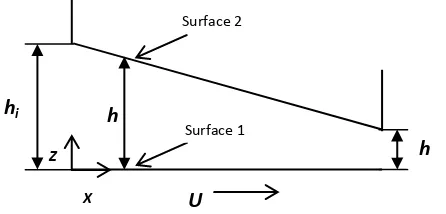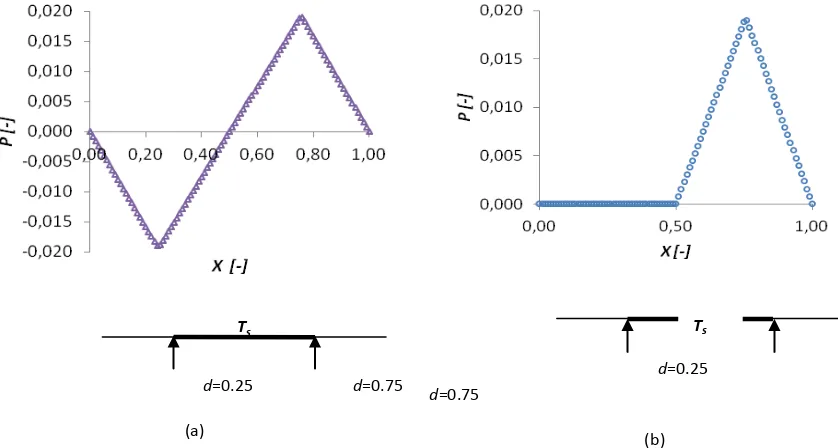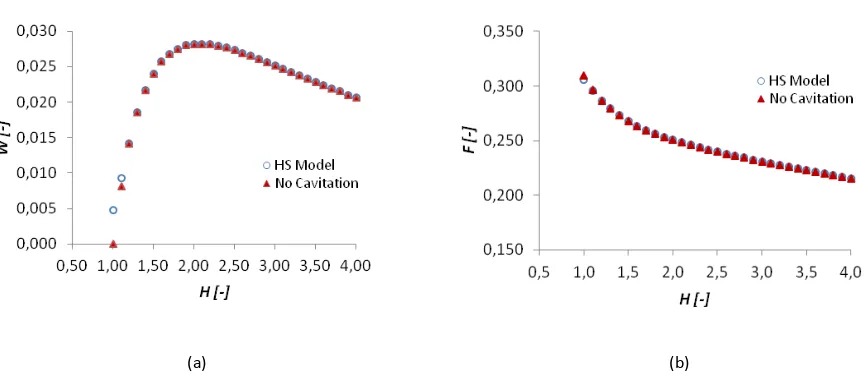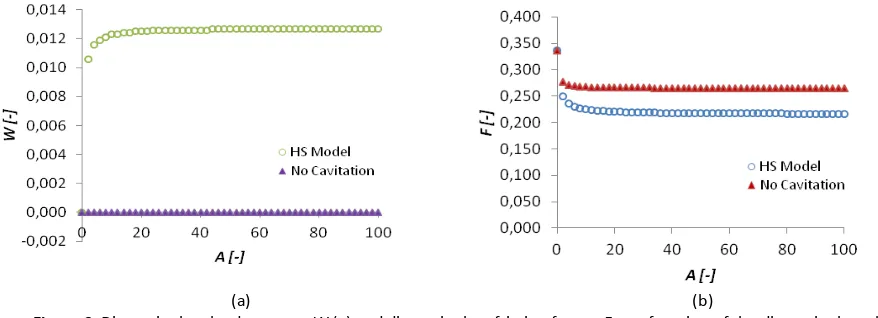Computational Analysis of Wall Slip and Cavitation in
Lubricated Sliding Systems
Muchammada, M. Tauviqirrahmana, J. Jamarib, and D.J. Schippera
a
Laboratory for Surface Technology and Tribology, Faculty of Engineering Technology, University of Twente Drienerloolaan 5, Postbus 217, 7500 AE, Enschede, THE NETHERLANDS
b
Department of Mechanical Engineering, University of Diponegoro, INDONESIA
Jl. Prof. Soedharto, Tembalang, Semarang, Indonesia, Phone: 024-7460059 ext. 115, Fax: 024-7460059 ext. 102 E-mail : [email protected]
Abstract :
Lubrication is applied to systems in which parts are in relative motion to avoid direct contact between the surfaces. The behavior of the fluid-film in sliding bearings depends on the boundary conditions at the interface between the liquid and the surfaces. Many researchers have found that wall slip may occur on specially engineered surfaces. A modified Reynolds equation with slip boundary conditions is proposed. This paper shows the performance of hydrodynamic lubrication in flat sliding bearing contacts in for instance MEMS (Micro Electro Mechanical System) using a slip surface. Parameters such as the slope incline ratio, slip length, and slip area are used to calculate the load support and friction. The wall slip is based on the Navier relation. The modified Reynolds equation is discretized by finite volume methods and solved by the Tridiagonal Matrix Algoritma (TDMA). The occurrence of cavitation phenomena is modeled using the Half-Sommerfeld approach. Results show that applying slip and the cavitation condition may increases the performance of sliding lubricated contacts.
Keywords: cavitation, computational analysis, MEMS, sliding bearing, wall slip.
1. Introduction
In the classical liquid lubrication it is assumed that surfaces are fully-flooded and the no-slip condition is present between the liquid and the solid surface. For most applications, the no-slip boundary condition is a good assumption. In MEMS, this wetting condition is actually an unwanted process because it causes stiction and as a result parts of the MEMS cannot be moved.
The effectiveness of lubrication in MEMS devices is challenging, primarily because the high surface area against the volume ratio in MEMS devices causes the surface forces to out weight the influences of inertia, leading to stiction and increase surface loads. Recently, with sophisticated experimental methods, such as nano particles image velocimetry (NPIV) [1], atomic force microscope (AFM) [2] and surface force apparatus (SFA) [3], the slip between the surface and liquid, i.e. wall slip, has been researched not only for the hydrophobic surfaces [1-3] but also for hydrophilic surfaces [2]. In the present study, the development of surface slip phenomena to improve the performance of sliding bearings is solved by means of a numerical analysis. It is expected that a surface with partially slip conditions will increase the performance of bearing characteristics, such as load support and friction. Richard et al. [4] proposed a numerical analysis for a slider bearing with such an engineered slip/ no-slip surface. Slip is assumed to occur when a critical shear stress is exceed, the Navier slip condition. The results showed that with a critical shear stress of zero, a significant increase in load support and decrease in friction can be achieved with an appropriate surface pattern. With non-zero values for the critical shear stress, the instability occurs over a wide speed range. Some result were shown by Fortier et al. [5] who examined the influence of such a heterogeneous slip/ no-slip surface of a journal bearing on the load support and friction. Tauviqirrahman et al. [6] proposed an improvement in load support by heterogeneous slip at the surface of a sliding bearing, so that the load support is that of a corresponding sliding contact with a homogeneous slip surface, even when there is no wedge effect.
mass is not conserved in the cavitation region. The first algorithm model using finite element cavitation was proposed by Kumar and Booker [10]. The gas/ vapor area was assumed compressible with zero bulk modulus. However, some numerical problems occurred, when the mesh or the integration method changed [11]. The aim of this work is to recognize the importance of the theoretical modeling of cavitation and the presence of wall slip in lubricated mechanisms.
2. Mathematical Formulation
Let us consider a lubricated infinite wide sliding bearing in which the lower surface is moving part in x direction, and the upper surface is stationary, see (Figure. 1). The Navier-Stokes equations for this situation reduce to:
0
0
p
u
x
z
z
p
y
p
z
[1]The Navier slip boundary condition, which stipulates that the wall slip is proportional to shear stress by the
give slip oeffi ie t α, reads;
( , 0)
( , )
hz h
u x
U
u
u x z
z
[2]The ultipli atio of the slip oeffi ie t y the vis osity, αμ is o o ly a ed slip le gth .
Figure 1. Schematic representation of sliding bearing configuration.
Experiments studying the wall slip [12] show that the slip length ranges from molecular scale to values larger than the film thickness. Using equation 1 and 2, one obtains the following modified Reynolds equation [6];
2
3
4
2
6
h h h hh
h
p
h
U
x
x h
x h
[3]In this work the modified Reynolds equation is discretized by finite volume methods and solved by the
Tridiagonal Matrix Algoritma (TDMA). The entire computed domain is assumed as full fluid lubrication. The occurrence of cavitation phenomena is modeled using the Half-Sommerfeld approach.
X
h
U
Surface 2
Z
hi h
3. Result and Discussion.
3.1. Cavitation in sliding contacts with slip
The effect of cavitation in lubricated devices has been studied for years [7] and was recently reconsidered in situations where the surface roughness had to be taken into account [13]. The Half-Sommerfeld (HS) model consists of solving the Reynolds equation with its boundary conditions, i.e. replacing the negative pressure by zero.
The major drawback of this model is that it is a non-conservative cavitation model.
d=0.25 d=0.75 (a)
d=0.25
d=0.75
(b)
Figure 2. Effect of the dimensionless pressure, P as a function of dimensionless length, H = 1, (parallel sliding surfaces), slip area d = 0.25 – 0.75 α=0 ; a No avitatio a d HS avitatio odel.
d=0.25 d=0.75
(a)
d=0.25 d=0.75
(b)
Figure 3. Effect of the dimensionless pressure, P as a function of the dimensionless length, H = 2, slip area d = 0.25 –0.75 α = 0); (a) No cavitation and (b) HS cavitation model.
Figure 2 shows the effect of dimensionless the pressure, P as function of the dimensionless length, X in case of no cavitation and the Half Sommerfeld (HS) cavitation model. The dimensionless pressure is defined as P=pho
2
/6 µULx. In case (a) no cavitation is considered and negative pressure is detected in the inlet of the bearing and in
Ts Ts
case (b) where the HS cavitation model is used not. Figure 3 shows the results for H=2 for: (a) no cavitation and (b) the use of the HS cavitation model. It does not show negative pressures and the value of the dimensionless pressure is the same for both no cavitation and the HS cavitation model. This is due to in real system, the negative pressure is inpractical. For this reason, it is necessary to focus on modeling cavitation in which the real characteristic of lubrication system is included.
3.2. Slip in Sliding Bearing Contacts with Cavitation
(a) (b)
Figure 4. Dimensionless load support, W (a) and dimensionless friction factor, F (b) as a function of the slope incline ratio, Hi for infinite wide sliding bearings.
Figure 4 is a graph of the variation of dimensionless load support, W and friction factor, F with respect to the dimensionless slope incline, H. The load support W is defined as W = who2/6 µULx2 and the friction factor F is defined as F= fho2/ µULx2. H is the ratio of inlet to outlet film thickness and therefore starts at a value of 1, which represent parallel sliding surfaces which have zero load support and no effect of cavitation is found. The load
support increases with increasing H until a maximum value is attained at H is approximately 2, after which it starts to decreases. The calculated results for the dimensionless friction factor, F as a function of the slope incline ratio, H
is presented in Fig. 4.b. It shows that with increasing H, the friction forces decrease. Both the HS cavitation model and no cavitation give similar results and it means that cavitation is not an issue.
(a) (b)
Figure 5. Dimensionless load support, W (a) and dimensionless friction factor, F (b) as a function of the dimensionless length slip zone, Ls in parallel sliding surfaces, H = 1.
prediction of load support is unstable and allowing to have negative values. While using the HS cavitation model load support, W is predicted and shows that there is optimum W for the dimensionless length of the slip zone. With respect to the friction factor, F both approaches (HS cavitation model and no cavitation) calculates equal values for the friction factor, F.
(a) (b)
Figure 6. Dimensionless load support, W (a) and dimensionless friction factor, F as a function of the dimensionless slip coefficient, A for parallel sliding surfaces, H = 1.
Figure 6 shows the effect of the dimensionless load support, W and dimensionless friction factor, F on the dimensionless slip length coefficient, A of the sliding contact with no cavitation and using HS the cavitation model for parallel sliding surfaces. As expected that when H =1, there is no load support when cavitation is not into account for all values of the dimensionless slip length coefficient. A different result is obtained if the HS cavitation is employed. The HS cavitation model for parallel sliding surfaces predict load support if H = 1. Figure 6(b) shows
the behavior of friction factor with changing dimensionless slip length coefficient, A, a low friction force is maintained for A larger then approximately 10.
4. Conclusion
The result of this study shows that the use of a slip area improves the lubrication performance of sliding bearings. The HS cavitation model was applied in the present study and showed to be of importance in predicting the load support, for parallel sliding bearings.
Nomenclatures
A = dimensionless slip oeffi ie t, αµ/ho d = distance of the slip zone Ts from the inlet f = friction factor
F = dimensionless friction factor h = film thickness
Hi = ratio of inlet to outlet film thickness, hi/ho hi = inlet film thickness
ho = outlet film thickness ls = length of the slip zone
Ls = dimensionless length of the slip zone, ls/Lx lx = length of sliding bearing
p = pressure
P = dimensionless pressure Ts = slip area
U = Velocity of moving surface w = load support
W = dimensionless load support X = dimensionless length, x/Lx x = x coordinate
y = y coordinate z = z coordinate
α = slip coefficient µ = viscosity of the fluid
Acknowledgements
References
[1] Pit R, Hervet H, Leger L. 2000. Direct Experimental Evidence of Slip in Hexadecane: Solid Interfaces, Physical Review Letters, 85 : 980-983.
[2] Craig VSJ, Neto C, Williams DRM. 2001. Shear-Dependent Boundary Slip in an Aqueous Newtonian Liquid, Physical Review Letters, 87 : 054504.
[3] Zhu Y, Granick S. 2001. Rate-Dependent Slip of Newtonian Liquid at Smooth Surface, Physical Review Letters, 87 : 096105. [4] Richard FS, Alicia EF. 2004. Numerical Analysis of a Slider Bearing with a Heterogeneous Slip/ No-Slip Surface, Tribology
Transaction, 47 : 328-334.
[5] Alicia EF, Richard FS. 2005. Numerical Analysis of a Journal Bearing with a Heterogeneous Slip/ No-Slip Surface, ASME Journal of Tribology, 127 : 820-825.
[6] Tauviqirrahman M, Ismail R, Jamari J, and Schipper DJ. 2011. Effect of Boundary Slip on the Load Support in a Lubricated Sliding Contact, The 4th Nanotechnology Symposium (NNS2011) AIP Conf. Proc., 1415 : 51-54.
[7] Dowson D, Taylor CM. 1979. Cavitation in Bearing, A. Re. Fluid Mec, p. 35-66.
[8] Booker JF. 1990. Classic Cavitation Models for Finite Element Analysis, in D.E. Brewe, J.H. Ball and M.M. Khonsari (eds.), Current Research in Cavitation Fluid Films, STLE Special Publication, SP-28 : 39-40.
[9] Oh KP, Goenka, PK. 1985. The Elastohydrodynamic Solution of Journal Bearing Under Dynamic Loading, ASME Journal Tribology, 107 : 389-395.
[10] Kumar K, Booker JF. 1991. A Finite Element Cavitation Algorithm: Aplication/ Validation, ASME Jornal Tribology, 107 : 255-260.
[11] Goenka PK, Parandje RS. 1991. Discussion of the Paper a Finite Element Cavitation Algorithm by A. Kumar and J.F. Booker,
ASME Journal Tribology, 113 : 284-285.
[12] Eric L, Michael PB, Howard AS. 2007. Microfluidic: The No-Slip Boundary Condition, Handbook of Experimental Fluid Dynamics, Springer, New York p. 1219-1240.



